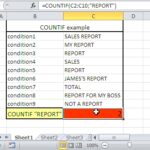Finding Names and Values with Precision using Match Function in Excel
We will explore the ins and outs of the Excel MATCH function and how it can simplify your data analysis tasks.
Table of Contents
How to Use MATCH Function in Excel
To begin harnessing the capabilities of the MATCH function, it’s essential to understand its syntax and arguments. The MATCH function is structured as follows:
=MATCH(lookup_value, lookup_array, [match_type])
- Lookup_value: The value you want to find in the lookup_array.
- Lookup_array: The range of cells where you want to search for the lookup_value.
- Match_type (optional): An argument that specifies the type of match to perform. It can be set to -1, 0, or 1 for different types of matches.
Using examples, we can illustrate the impact of each match_type:
- Exact Match (0): This is the default match_type. It finds the exact match of the lookup_value in the lookup_array.
- Less Than Match (-1): It finds the largest value in the lookup_array that is less than or equal to the lookup_value.
- Greater Than Match (1): It finds the smallest value in the lookup_array that is greater than or equal to the lookup_value.
How to Use MATCH Function with Wildcards
Sometimes, you may need to find partial matches or deal with variations in spelling. The MATCH function can handle this using wildcard characters:
- Asterisk (*) represents any number of characters.
- Question mark (?) represents a single character.
For instance, you can use *Smith* as the lookup_value to find all entries containing “Smith” in the lookup_array.
How to Use Case-Sensitive MATCH Function
By default, the MATCH function is not case-sensitive. To make it case-sensitive, you can use the EXACT function. Here’s an example:
=MATCH(TRUE, EXACT(lookup_value, lookup_array), 0)
This formula compares the text values in a case-sensitive manner.
Comparing Two Lists for Matches and Differences
To compare two lists for matches and differences, you can use the ISNA and MATCH functions together. If you want to find values present in one list but not in another, you can use the following formula:
=IF(ISNA(MATCH(value, other_list, 0)), “Not Found”, “Found”)
This formula will help you quickly identify discrepancies between lists.
Using MATCH Function with VLOOKUP and HLOOKUP
The MATCH function becomes particularly valuable when combined with the VLOOKUP and HLOOKUP functions. By using MATCH in conjunction with these functions, you can create dynamic lookup formulas that automatically adjust to changes in the lookup table. Here’s an example of how to use VLOOKUP and MATCH together:
=VLOOKUP(lookup_value, table_array, MATCH(lookup_value, header_row, 0), FALSE)
In this formula, MATCH dynamically locates the column index, ensuring accurate lookups even when the table structure changes.



